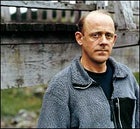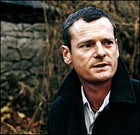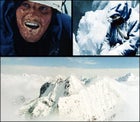Making the Cut (original) (raw)
New perk: Easily find new routes and hidden gems, upcoming running events, and more near you. Your weekly Local Running Newsletter has everything you need to lace up! Subscribe today.
BEFORE TRAVELING back to the Peruvian Andes for the first time in 17 years, Joe Simpson recalls, friends suggested the trip would do him good. “Because that’s what people believe, don’t they? That it’s cathartic to go back to where you had a horrible, painful time, so you can get over it.” He scoffs, “What a load of bollocks!”
Mountaineering, Touching the Void, Peru, Andes
 “I’ll always be known for cutting the rope”: Yates, in Penrith, England
“I’ll always be known for cutting the rope”: Yates, in Penrith, England
Mountaineering, Touching the Void, Peru, Andes
 “What happpened in Peru didn’t push us apart”: Simpson, in Kendal, England
“What happpened in Peru didn’t push us apart”: Simpson, in Kendal, England
Mountaineering, Touching the Void, Peru, Andes
 Stills from Touching the Void:Clockwise from left, Actor Brendan Mackey as Simpson trapped in the crevasse; a moment of hope after the improbable escape; Siula Grande.
Stills from Touching the Void:Clockwise from left, Actor Brendan Mackey as Simpson trapped in the crevasse; a moment of hope after the improbable escape; Siula Grande.
The 44-year-old British mountaineer had agreed to fly to Peru in 2002 with his former climbing partner, Simon Yates, 40, to shoot scenes for Touching the Void, a new film based on Simpson’s 1988 book of the same name, a million-plus bestseller and modern adventure classic. The $2 million film, directed by Academy Award winner Kevin Macdonald and distributed by IFC Films, is one of those rare documentaries to see national theatrical release, kicking off in select cities on January 23 and expanding through February and March. Rarer still, it actually gets mountaineering right.
“For once, someone’s done a feature film about climbing very, very well,” says Michael Brown, 37, an accomplished Himalayan mountaineer and director of Farther Than the Eye Can See, Outside Television’s documentary about blind climber Erik Weihenmayer and his 2001 ascent of Mount Everest. “Usually, it’s so far from reality, you just sit there and laugh. But this movie has credibility right from the start.”
Faithful to the book, Touching the Void chronicles Simpson and Yates’s 1985 perilous first ascent of the 4,500-foot west face of 20,853-foot Siula Grande. Climbing alpine style—fast and light, with no set camps—they took on bitter winds and heavy-laden cornices of snow but summited in three and a half days.
On the descent, however, Simpson fell down a 20-foot ice cliff. With his right leg shattered, he relied on Yates to lower him down the mountain 300 feet at a time, on two knotted ropes. They made slow progress for a few hours, a blizzard descending upon them. But when Simpson slid over a second cliff, Yates, unable to see his partner or haul him up, fought for over an hour to keep both of them from plummeting into the void. As a last resort to save himself, Yates made the only choice he could: He cut the rope.
Miraculously, Simpson survived a 150-foot fall into a deep crevasse. Yates, who couldn’t hear Simpson’s shouts, gave his partner up for dead. Plagued by guilt, Yates made it back to their base camp while Simpson endured an agonizing self-rescue, escaping the crevasse and dragging himself over the glacier and rocky moraine for three and a half days, crazed with thirst, and desperately following Yates’s footprints even as fresh snow erased them. (Upon returning to England, Simpson underwent six operations and two years of rehab before resuming climbing in the major ranges.)
Macdonald, 36—a Briton who won the Oscar for One Day in September, a 2000 documentary about the Israeli athletes murdered at the 1972 Munich Olympics—struggled at first with how to tell the highly psychological story. “I’m a purist,” he says. “I don’t like casually blurring the lines of documentary and drama.”
He settled on a clearly delineated docudrama. A reenactment of the climb and Simpson’s self-rescue—featuring British actors Brendan Mackey, as Simpson, and Nicholas Aaron, as Yates, as well as several stuntmen—was filmed at three locations in the Alps during punishing snowstorms. Those sequences are intercut with London studio interviews featuring Simpson, Yates, and Richard Hawking, a fellow Brit who tended their base camp. The three narrate the action, their faces and voices revealing not only what it felt like in the moment but what it’s been like to live with the memories. Yates stammers as he describes the instant he remembered he had a knife in his pack; Simpson’s eyes well up when he recalls his near-death loneliness.
For the film’s few Peru segments, Simpson and Yates doubled as their younger selves for long-distance shots of the snow-fluted couloirs of Siula Grande. They didn’t stay long. “Seeing those landmarks, the dread came screaming back,” Simpson says. “It was deeply unpleasant.” Two weeks after returning home, Simpson was diagnosed with post-traumatic stress disorder. During the shoot, Yates lost patience with Macdonald’s multiple takes. By the end of their time in Peru, he and the director weren’t speaking. “He accused me of having repressed emotions about what happened,” Yates recalls, mystified. “I was just ready to be done with it.”
For both climbers, the film promises renewed—and bittersweet—notoriety. Following the 1988 publication of Touching the Void, Simpson became a much-sought-after corporate speaker, and he went on to write five more books. Yates encountered mixed reviews upon returning home in 1985. As the story played out in the press, not everyone got it straight: UK newspaper The Mail on Sunday wrote that Yates “had tried and sentenced his best friend to death.” However, once Yates and Simpson published their own accounts, most climbers took up Yates’s defense. “Anyone who’s critical of Simon hasn’t got a clue,” says British climbing great Sir Chris Bonington, 69. “If you have a grasp of the circumstances, you appreciate that he had no choice.”
Despite the flak, Yates didn’t miss a beat. Two months after the Peru epic, he was in the Alps; he’s never lacked for climbing partners, and today he runs Mountain Dream, an international guiding business. For all that, though, he remains the Guy Who Cut the Rope.
“You’ve got to laugh at it,” Yates says. And he does, in The Flame of Adventure, his second book, published in 2002 by The Mountaineers Books. In it, he describes the hazing he endured at a London construction site where he worked—often roped up—to pay for trips. Nicknamed “Slasher,” he arrived one day to find SLASHER WAS ‘ERE penned across a poster showing a fallen high-rise worker dead in a pool of blood.
In his book, Simpson describes Yates as “everything I would like to have been…dependable, sincere, ready to see life as a joke.” But over the years, the two drifted apart, teaming up on only one foreign expedition, to India’s Garhwal Himalaya, in 1991. “What happened in Peru didn’t push us apart,” Simpson says, “but it didn’t make us closer, either.” The new film appears to have had the same effect: As it toured festivals late last fall, the two had a brief falling out over promotional duties.
“It’s two-edged, isn’t it?” Yates says of the odd fame the rope cutting still brings him. “I make my living around mountaineering, so it’s helped. It’s gotten my name out there. But it is strange. Whatever I do in life, I’ll be known for that.”
Typically, when Hollywood goes to the mountains, strange things happen: Climbers leap from helicopters with nitroglycerin strapped to their backs and Sylvester Stallone fires a gun that shoots bolts into solid granite. All of which is good for high-velocity viewing but makes real mountaineers smack their foreheads in stupefaction. Below, we critique four screen moments best enjoyed with a climbing buddy and a few heady stouts.
Vertical Limit (2000)
The Reel Story:
On K2, Chris O’Donnell leaps over a massive gap and instantly glues himself to a far wall with his ice axes.
The Real Story:
His arms would have been torn from their sockets, perhaps making this film worth watching.
Mission: Impossible 2 (2000)
The Reel Story:
Tom Cruise solos unroped up a cliff, performing an unlikely series of dynos and crucifix-style deadman hangs.
The Real Story:
Cruise did the climbing, but there was a cable holding his ass to the wall—they just digitally erased it.
Cliffhanger (1993)
The Reel Story:
On a Tyrolean traverse over a canyon, Michelle Joyner’s metal harness buckle breaks and she plunges to her death.
The Real Story:
Bad Michelle—too many doughnuts! Those harnesses are rated to only 3,372 pounds of force!
The Holy Mountain (1926)
The Reel Story:
Cut from a dancing Leni Riefenstahl to two climbers on an icy ledge. One produces an accordion and starts to play; a bit later, his cohort falls off.
The Real Story:
Mein Gott! He must have dispatched his partner with the sinister HAPE (high-altitude polka execution) method!